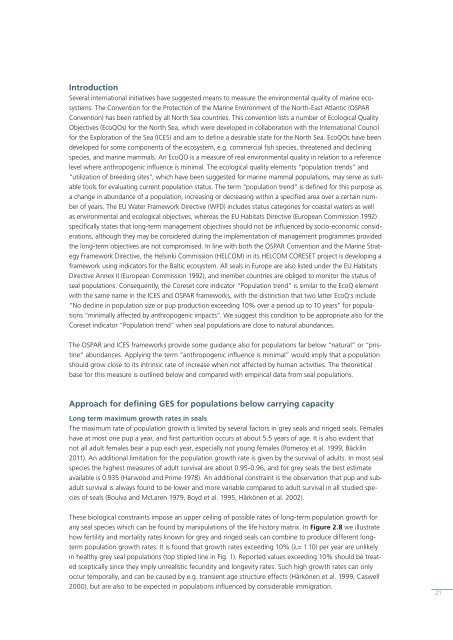Interim report of the HELCOM CORESET project
Interim report of the HELCOM CORESET project
Interim report of the HELCOM CORESET project
Create successful ePaper yourself
Turn your PDF publications into a flip-book with our unique Google optimized e-Paper software.
Introduction<br />
Several international initiatives have suggested means to measure <strong>the</strong> environmental quality <strong>of</strong> marine ecosystems.<br />
The Convention for <strong>the</strong> Protection <strong>of</strong> <strong>the</strong> Marine Environment <strong>of</strong> <strong>the</strong> North-East Atlantic (OSPAR<br />
Convention) has been ratifi ed by all North Sea countries. This convention lists a number <strong>of</strong> Ecological Quality<br />
Objectives (EcoQOs) for <strong>the</strong> North Sea, which were developed in collaboration with <strong>the</strong> International Council<br />
for <strong>the</strong> Exploration <strong>of</strong> <strong>the</strong> Sea (ICES) and aim to defi ne a desirable state for <strong>the</strong> North Sea. EcoQOs have been<br />
developed for some components <strong>of</strong> <strong>the</strong> ecosystem, e.g. commercial fi sh species, threatened and declining<br />
species, and marine mammals. An EcoQO is a measure <strong>of</strong> real environmental quality in relation to a reference<br />
level where anthropogenic infl uence is minimal. The ecological quality elements “population trends” and<br />
“utilization <strong>of</strong> breeding sites”, which have been suggested for marine mammal populations, may serve as suitable<br />
tools for evaluating current population status. The term “population trend” is defi ned for this purpose as<br />
a change in abundance <strong>of</strong> a population, increasing or decreasing within a specifi ed area over a certain number<br />
<strong>of</strong> years. The EU Water Framework Directive (WFD) includes status categories for coastal waters as well<br />
as environmental and ecological objectives, whereas <strong>the</strong> EU Habitats Directive (European Commission 1992)<br />
specifi cally states that long-term management objectives should not be infl uenced by socio-economic considerations,<br />
although <strong>the</strong>y may be considered during <strong>the</strong> implementation <strong>of</strong> management programmes provided<br />
<strong>the</strong> long-term objectives are not compromised. In line with both <strong>the</strong> OSPAR Convention and <strong>the</strong> Marine Strategy<br />
Framework Directive, <strong>the</strong> Helsinki Commission (<strong>HELCOM</strong>) in its <strong>HELCOM</strong> <strong>CORESET</strong> <strong>project</strong> is developing a<br />
framework using indicators for <strong>the</strong> Baltic ecosystem. All seals in Europe are also listed under <strong>the</strong> EU Habitats<br />
Directive Annex II (European Commission 1992), and member countries are obliged to monitor <strong>the</strong> status <strong>of</strong><br />
seal populations. Consequently, <strong>the</strong> Coreset core indicator “Population trend” is similar to <strong>the</strong> EcoQ element<br />
with <strong>the</strong> same name in <strong>the</strong> ICES and OSPAR frameworks, with <strong>the</strong> distinction that two latter EcoQ:s include<br />
“No decline in population size or pup production exceeding 10% over a period up to 10 years” for populations<br />
“minimally affected by anthropogenic impacts”. We suggest this condition to be appropriate also for <strong>the</strong><br />
Coreset indicator “Population trend” when seal populations are close to natural abundances.<br />
The OSPAR and ICES frameworks provide some guidance also for populations far below “natural” or “pristine”<br />
abundances. Applying <strong>the</strong> term “anthropogenic infl uence is minimal” would imply that a population<br />
should grow close to its intrinsic rate <strong>of</strong> increase when not affected by human activities. The <strong>the</strong>oretical<br />
base for this measure is outlined below and compared with empirical data from seal populations.<br />
Approach for defi ning GES for populations below carrying capacity<br />
Long term maximum growth rates in seals<br />
The maximum rate <strong>of</strong> population growth is limited by several factors in grey seals and ringed seals. Females<br />
have at most one pup a year, and fi rst parturition occurs at about 5.5 years <strong>of</strong> age. It is also evident that<br />
not all adult females bear a pup each year, especially not young females (Pomeroy et al. 1999, Bäcklin<br />
2011). An additional limitation for <strong>the</strong> population growth rate is given by <strong>the</strong> survival <strong>of</strong> adults. In most seal<br />
species <strong>the</strong> highest measures <strong>of</strong> adult survival are about 0.95-0.96, and for grey seals <strong>the</strong> best estimate<br />
available is 0.935 (Harwood and Prime 1978). An additional constraint is <strong>the</strong> observation that pup and subadult<br />
survival is always found to be lower and more variable compared to adult survival in all studied species<br />
<strong>of</strong> seals (Boulva and McLaren 1979, Boyd et al. 1995, Härkönen et al. 2002).<br />
These biological constraints impose an upper ceiling <strong>of</strong> possible rates <strong>of</strong> long-term population growth for<br />
any seal species which can be found by manipulations <strong>of</strong> <strong>the</strong> life history matrix. In Figure 2.8 we illustrate<br />
how fertility and mortality rates known for grey and ringed seals can combine to produce different longterm<br />
population growth rates. It is found that growth rates exceeding 10% (�= 1.10) per year are unlikely<br />
in healthy grey seal populations (top stipled line in Fig. 1). Reported values exceeding 10% should be treated<br />
sceptically since <strong>the</strong>y imply unrealistic fecundity and longevity rates. Such high growth rates can only<br />
occur temporally, and can be caused by e.g. transient age structure effects (Härkönen et al. 1999, Caswell<br />
2000), but are also to be expected in populations infl uenced by considerable immigration.<br />
21













